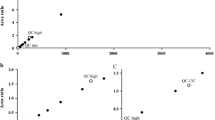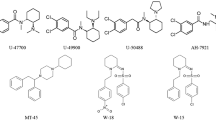Abstract
In postmortem toxicology, fast methods can provide a triage to avoid unnecessary autopsies. Usually, this requires multiple qualitative and quantitative analytical methods. The aim of the present study was to develop a postmortem LC-QTOF method for simultaneous screening and quantitation using easy sample preparation and reduced alternative calibration models. Hence, a method for 24 highly relevant substances in forensic toxicology was fully validated using the following calibration models: one-point external, one-point internal via corresponding deuterated standards, multi-point external daily calibration, and multi-point external weekly calibration. Two hundred microliters of postmortem blood were spiked with internal deuterated standard mixture and extracted by acetonitrile protein precipitation. Analysis was performed on a Sciex 6600 QTOF instrument with ESI+ mode using data-independent acquisition (DIA) namely sequential window acquisition of all theoretical mass spectra (SWATH). Validation of the different calibration models included selectivity, autosampler stability, recovery, matrix effects, accuracy, and precision for 24 substances. In addition, corresponding deuterated analogs of 52 substances were included to the internal standard mix for semi-quantitative concentration assessment. The simple protein precipitation provided recoveries higher than 55 and 75% for all analytes at low and high concentrations, respectively. Accuracy and precision criteria (bias and imprecision ± 15 and ± 20% near the limit of quantitation) were fulfilled by the different calibration models for most analytes. The validated method was successfully applied to more than 100 authentic postmortem samples and 3 proficiency tests. Furthermore, the one-point internal calibration via corresponding deuterated standard proved to be a considerably time saving technique for 76 analytes.

One-point and multi-point calibration and the resulting beta-tolerance intervals from method validation




Similar content being viewed by others
References
Birkler RID, Telving R, Ingemann-Hansen O, Charles AV, Johannsen M, Andreasen MF. Screening analysis for medicinal drugs and drugs of abuse in whole blood using ultra-performance liquid chromatography time-of-flight mass spectrometry (UPLC–TOF-MS)—toxicological findings in cases of alleged sexual assault. Forensic Sci Int. 2012;222(1):154–61. https://doi.org/10.1016/j.forsciint.2012.05.019.
EMCDDA. European drug report 2016—trends and developments. Lisbon: European Monitoring Centre for Drugs and Drug Addiction (EMCDDA) 2016.
Mounteney J, Griffiths P, Sedefov R, Noor A, Vicente J, Simon R. The drug situation in Europe: an overview of data available on illicit drugs and new psychoactive substances from European monitoring in 2015. Addiction. 2016;111(1):34–48. https://doi.org/10.1111/add.13056.
EMCDDA. New Psychoactive substamces in Europe. An update from the EU early warning system. Lisbon: European Monitoring Centre for Drugs and Drug Addition (EMCDDA) 2015.
Maurer HH. Multi-analyte procedures for screening for and quantification of drugs in blood, plasma, or serum by liquid chromatography-single stage or tandem mass spectrometry (LC-MS or LC-MS/MS) relevant to clinical and forensic toxicology. Clin Biochem. 2005;38(4):310–8. https://doi.org/10.1016/j.clinbiochem.2005.01.014.
Steuer AE, Forss AM, Dally AM, Kraemer T. Method development and validation for simultaneous quantification of 15 drugs of abuse and prescription drugs and 7 of their metabolites in whole blood relevant in the context of driving under the influence of drugs-usefulness of multi-analyte calibration. Forensic Sci Int. 2014;244:92–101. https://doi.org/10.1016/j.forsciint.2014.08.022.
Johansen SS, Bhatia HM. Quantitative analysis of cocaine and its metabolites in whole blood and urine by high-performance liquid chromatography coupled with tandem mass spectrometry. J Chromatogr B Analyt Technol Biomed Life Sci. 2007;852(1–2):338–44. https://doi.org/10.1016/j.jchromb.2007.01.033.
Montenarh D, Hopf M, Maurer HH, Schmidt P, Ewald AH. Development and validation of a multi-analyte LC-MS/MS approach for quantification of neuroleptics in whole blood, plasma, and serum. Drug Test Anal. 2016;8(10):1080–9. https://doi.org/10.1002/dta.1923.
Steuer AE, Poetzsch M, Koenig M, Tingelhoff E, Staeheli SN, Roemmelt AT, et al. Comparison of conventional liquid chromatography-tandem mass spectrometry versus microflow liquid chromatography-tandem mass spectrometry within the framework of full method validation for simultaneous quantification of 40 antidepressants and neuroleptics in whole blood. J Chromatogr A. 2015;1381:87–100. https://doi.org/10.1016/j.chroma.2014.12.084.
Musshoff F, Trafkowski J, Kuepper U, Madea B. An automated and fully validated LC-MS/MS procedure for the simultaneous determination of 11 opioids used in palliative care, with 5 of their metabolites. J Mass Spectrom. 2006;41(5):633–40. https://doi.org/10.1002/jms.1021.
Fernandez Mdel M, Wille SM, Kummer N, Di Fazio V, Ruyssinckx E, Samyn N. Quantitative analysis of 26 opioids, cocaine, and their metabolites in human blood by ultra performance liquid chromatography-tandem mass spectrometry. Ther Drug Monit. 2013;35(4):510–21. https://doi.org/10.1097/FTD.0b013e31828e7e6b.
Bjork MK, Nielsen MK, Markussen LO, Klinke HB, Linnet K. Determination of 19 drugs of abuse and metabolites in whole blood by high-performance liquid chromatography-tandem mass spectrometry. Anal Bioanal Chem. 2010;396(7):2393–401. https://doi.org/10.1007/s00216-009-3268-9.
Simonsen KW, Hermansson S, Steentoft A, Linnet K. A validated method for simultaneous screening and quantification of twenty-three benzodiazepines and metabolites plus zopiclone and zaleplone in whole blood by liquid-liquid extraction and ultra-performance liquid chromatography- tandem mass spectrometry. J Anal Toxicol. 2010;34(6):332–41.
Dussy FE, Hamberg C, Briellmann TA. Quantification of benzodiazepines in whole blood and serum. Int J Legal Med. 2006;120(6):323–30. https://doi.org/10.1007/s00414-005-0042-1.
Peters FT, Hartung M, Herbold M, Schmitt G, Daldrup T, Musshoff F. Appendix B to the GTFCh guidelines for quality assurance in forensic-toxicological analyses. Requirements for the validation of analytical methods. Toxichem Krimtech. 2009;76:185.
Tissue BM. Basics of analytical chemistry and chemical equilibria. Hoboken: Wiley; 2013.
Peters FT, Maurer HH. Systematic comparison of bias and precision data obtained with multiple-point and one-point calibration in six validated multianalyte assays for quantification of drugs in human plasma. Anal Chem. 2007;79(13):4967–76. https://doi.org/10.1021/ac070054s.
Roemmelt AT, Steuer AE, Kraemer T. Liquid chromatography, in combination with a quadrupole time-of-flight instrument, with sequential window acquisition of all theoretical fragment-ion spectra acquisition: validated quantification of 39 antidepressants in whole blood as part of a simultaneous screening and quantification procedure. Anal Chem. 2015;87(18):9294–301. https://doi.org/10.1021/acs.analchem.5b02031.
Huang Q, Yang L, Luo J, Guo L, Wang Z, Yang X, et al. SWATH enables precise label-free quantification on proteome scale. Proteomics. 2015;15(7):1215–23. https://doi.org/10.1002/pmic.201400270.
Li CX, Tan XF, Lim TK, Lin QS, Gong ZY. Comprehensive and quantitative proteomic analyses of zebrafish plasma reveals conserved protein profiles between genders and between zebrafish and human. Sci Rep-Uk. 2016;6:24329. https://doi.org/10.1038/srep24329.
Loke MF, Ng CG, Vilashni Y, Lim J, Ho B. Understanding the dimorphic lifestyles of human gastric pathogen Helicobacter pylori using the SWATH-based proteomics approach. Sci Rep-Uk. 2016;6:26784. https://doi.org/10.1038/srep26784.
Vowinckel J, Capuano F, Campbell K, Deery M, Lilley K, Ralser M. The beauty of being (label)-free: sample preparation methods for SWATH-MS and next-generation targeted proteomics (version 2; referees: 2 approved). F1000Res. 2014;2:272.
Hopfgartner G, Tonoli D, Varesio E. High-resolution mass spectrometry for integrated qualitative and quantitative analysis of pharmaceuticals in biological matrices. Anal Bioanal Chem. 2012;402(8):2587–96. https://doi.org/10.1007/s00216-011-5641-8.
Ma Y, Tanaka N, Vaniya A, Kind T, Fiehn O. Ultrafast polyphenol metabolomics of red wines using microLC-MS/MS. J Agric Food Chem. 2016;64(2):505–12. https://doi.org/10.1021/acs.jafc.5b04890.
Liu Y, Huttenhain R, Collins B, Aebersold R. Mass spectrometric protein maps for biomarker discovery and clinical research. Expert Rev Mol Diagn. 2013;13(8):811–25. https://doi.org/10.1586/14737159.2013.845089.
Ortea I, Rodríguez-Ariza A, Chicano-Gálvez E, Arenas Vacas MS, Jurado GB. Discovery of potential protein biomarkers of lung adenocarcinoma in bronchoalveolar lavage fluid by SWATH MS data-independent acquisition and targeted data extraction. J Proteome. 2016;138:106–14. https://doi.org/10.1016/j.jprot.2016.02.010.
Sajic T, Liu Y, Aebersold R. Using data-independent, high-resolution mass spectrometry in protein biomarker research: perspectives and clinical applications. Proteomics Clin Appl. 2015;9(3–4):307–21. https://doi.org/10.1002/prca.201400117.
Roemmelt AT, Steuer AE, Poetzsch M, Kraemer T. Liquid chromatography, in combination with a quadrupole time-of-flight instrument (LC QTOF), with sequential window acquisition of all theoretical fragment-ion spectra (SWATH) acquisition: systematic studies on its use for screenings in clinical and forensic toxicology and comparison with information-dependent acquisition (IDA). Anal Chem. 2014;86(23):11742–9. https://doi.org/10.1021/ac503144p.
Uges D. Hospital toxicology. In: Moffat ACOM, Widdop B, Galichet LY, editors. Clarke’s analysis of drugs and poisons in pharmaceuticals, body fluids and postmortem material. 3rd ed. London, UK: Pharmaceutical Press; 2004.
Schulz M, Iwersen-Bergmann S, Andresen H, Schmoldt A. Therapeutic and toxic blood concentrations of nearly 1,000 drugs and other xenobiotics. Crit Care. 2012;16(4):R136. https://doi.org/10.1186/cc11441.
Brunton L, Chabner B, Knollman B. Goodman and Gilman’s the pharmacological basis of therapeutics. twelfth ed. New York, NY: McGraw-Hill Education; 2011.
Matuszewski BK, Constanzer ML, Chavez-Eng CM. Strategies for the assessment of matrix effect in quantitative bioanalytical methods based on HPLC-MS/MS. Anal Chem. 2003;75(13):3019–30.
Meyer GMJ, Weber AA, Maurer HH. Development and validation of a fast and simple multi-analyte procedure for quantification of 40 drugs relevant to emergency toxicology using GC-MS and one-point calibration. Drug Testing and Analysis. 2014;6(5):472–81. https://doi.org/10.1002/dta.1555.
Ma Y-C, Wang C-W, Hung S-H, Chang Y-Z, Liu C-R, Her G-R. Estimation of the measurement uncertainty in quantitative determination of ketamine and Norketamine in urine using a one-point calibration method. J Anal Toxicol. 2012;36(7):515–22. https://doi.org/10.1093/jat/bks062.
Remane D, Meyer MR, Wissenbach DK, Maurer HH. Ultra high performance liquid chromatographic-tandem mass spectrometric multi-analyte procedure for target screening and quantification in human blood plasma: validation and application for 31 neuroleptics, 28 benzodiazepines, and Z-drugs. Anal Bioanal Chem. 2011;401(4):1341. https://doi.org/10.1007/s00216-011-5187-9.
Di Rago M, Saar E, Rodda LN, Turfus S, Kotsos A, Gerostamoulos D, et al. Fast targeted analysis of 132 acidic and neutral drugs and poisons in whole blood using LC–MS/MS. Forensic Sci Int. 2014;243:35–43. https://doi.org/10.1016/j.forsciint.2014.03.021.
Acknowledgments
The authors express their gratitude to Emma Louise Kessler, MD for her generous legacy she donated to the Institute of Forensic Medicine at the University of Zurich, Switzerland for research purposes.
Author information
Authors and Affiliations
Corresponding author
Ethics declarations
Authentic human blood samples were collected and analyzed anonymously from healthy volunteers who provided written informed consent. Postmortem blood samples were used after anonymization. According to Swissethics (Human Research Act, HRA), no further ethical approval from the cantonal ethic commission is necessary if the research is not aiming to investigate diseases or functions of the human body as has been the case in the current study.
Conflict of interest
The authors declare that they have no potential conflict of interest.
Electronic supplementary material
ESM 1
(PDF 93 kb).
Rights and permissions
About this article
Cite this article
Elmiger, M., Poetzsch, M., Steuer, A.E. et al. Assessment of simpler calibration models in the development and validation of a fast postmortem multi-analyte LC-QTOF quantitation method in whole blood with simultaneous screening capabilities using SWATH acquisition. Anal Bioanal Chem 409, 6495–6508 (2017). https://doi.org/10.1007/s00216-017-0594-1
Received:
Revised:
Accepted:
Published:
Issue Date:
DOI: https://doi.org/10.1007/s00216-017-0594-1




